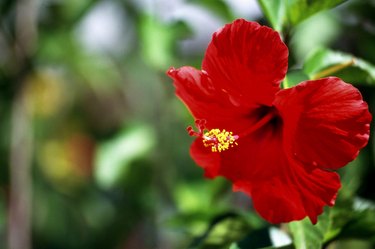
There are several types of hibiscus (Hibiscus spp.), but across the genus they are known for their lovely, colorful blooms. If your hibiscus has lighter, unhealthy-looking or yellow leaves, it may be suffering from a lack of acid. A simple water and vinegar treatment could help remedy this and get your plant fighting fit again in no time.
Identification
Video of the Day
Although its lush radial blooms are often associated with tropical locations, there are several varieties of hibiscus that grow well in more temperate areas of the United States. Rose mallow (Hibiscus moscheutos), for instance, hardy in U.S. Department of Agriculture plant hardiness zones 4 through 9, can grow in cold and even mountainous areas. Chinese hibiscus (Hibiscus rosa-sinensis), hardy in USDA zones 9 through 11, has a more exotic appeal.
Video of the Day
Acid Lovers
Hibiscus flowers prefer an acidic growing environment. Generally, they are happy in a pH range of between 6 and 7, though they may like it even lower. Because the pH level of the soil can have an effect on nutrient availability, it is important that hibiscus is grown in the correct range. If your plant seems to be suffering from a lack of acid, check its environment: growing near concrete and getting regular doses of hard water both raise soil pH. If your plant just needs a little dose of acid, vinegar might do it.
Vinegar Solutions
Watering hibiscus flowers with vinegar may work by temporarily boosting the acidity in the environment directly surrounding their roots. Dilute a cup of vinegar in a gallon of water and pour the whole solution onto the roots of the plant. The solution, which settles around the roots, unlocks vital nutrients in the soil, feeding hibiscus plants. Although vinegar is mild enough that you don't need to worry about wearing gloves, take care not to get the solution on leaves or flowers, which will die.
Soil Acidification
If you have tried watering with vinegar but haven't achieved drastic enough results, there are other ways to modify the pH level of your soil. At first you can try a timed-release fertilizer with an acidic pH, probably between 6 and 7. Fertilize lightly and often during the growing season, say at half the recommended dosage and twice the recommended rate. If that doesn't work, try elemental sulfur. Amounts vary depending on starting pH and desired ending point, but for instance, it will take about 2 pounds of elemental sulfur applied to 100 square feet of silt loam soil to lower pH from 7 to 6.